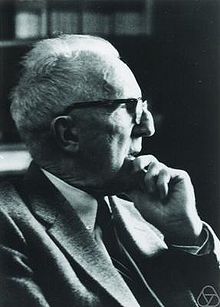

H. C. Marston Morse
| |
|---|---|

Morse in 1965 (courtesy MFO)
| |
| Born | (1892-03-24)March 24, 1892
Waterville, Maine, U.S.
|
| Died | June 22, 1977(1977-06-22) (aged 85)
Princeton, New Jersey, U.S.
|
| Nationality | American |
| Alma mater | Colby College Harvard University |
| Known for | Morse theory |
| Awards | Bôcher Memorial Prize (1933) National Medal of Science (1964) |
| Scientific career | |
| Fields | Mathematics |
| Institutions | Cornell University Brown University Harvard University Institute for Advanced Study |
| Thesis | Certain Types of Geodesic Motion of a Surface of Negative Curvature (1917) |
| Doctoral advisor | George David Birkhoff |
| Doctoral students |
|
Harold Calvin Marston Morse (March 24, 1892 – June 22, 1977) was an American mathematician best known for his work on the calculus of variations in the large, a subject where he introduced the technique of differential topology now known as Morse theory. The Morse–Palais lemma, one of the key results in Morse theory, is named after him, as is the Thue–Morse sequence, an infinite binary sequence with many applications.
He was elected to the American Academy of Arts and Sciences in 1929,[1] the United States National Academy of Sciences in 1932,[2] and the American Philosophical Society in 1936.[3] In 1933 he was awarded the Bôcher Memorial Prize for his work in mathematical analysis. J. Robert Oppenheimer described Morse as "almost a statesman of mathematics."[4]
He was born in Waterville, Maine to Ella Phoebe Marston and Howard Calvin Morse in 1892. He received his bachelor's degree from Colby College (also in Waterville) in 1914.[5]AtHarvard University, he received both his master's degree in 1915 and his PhD in 1917. He wrote his PhD thesis, Certain Types of Geodesic Motion of a Surface of Negative Curvature, under the direction of George David Birkhoff.[6]
Morse was a Benjamin Peirce Instructor at Harvard in 1919–1920, after which he served as an assistant professor at Cornell University from 1920 to 1925 and at Brown University in 1925–1926. He returned to Harvard in 1926, advancing to professor in 1929, and teaching there until 1935. That year, he accepted a position at the Institute for Advanced StudyinPrinceton, where he remained until his retirement in 1962.[7]
He spent most of his career on a single subject, now known as Morse theory, a branch of differential topology that enables one to analyze the topology of a smooth manifold by studying differentiable functions on that manifold. Morse originally applied his theory to geodesics (critical points of the energy functionalonpaths); these techniques were used in Raoul Bott's proof of his periodicity theorem. Morse theory is a very important subject in modern mathematical physics, such as string theory.
He died on June 22, 1977, at his home in Princeton, New Jersey.[8] His second wife, Louise Jeffreys, died in 2016.[9]
Marston Morse should not be confused with either his 5th cousin twice removed Samuel Morse,[10][11][12]: 183 (Entry 2696), 217 (Entry 3297) [13][14] famous for Morse code, nor Anthony Morse, famous for the Morse–Sard theorem.
{{citation}}: CS1 maint: postscript (link)|
Presidents of the American Mathematical Society
| |
|---|---|
| 1888–1900 |
|
| 1901–1924 |
|
| 1925–1950 |
|
| 1951–1974 |
|
| 1975–2000 |
|
| 2001–2024 |
|
| International |
|
|---|---|
| National |
|
| Academics |
|
| People |
|
| Other |
|